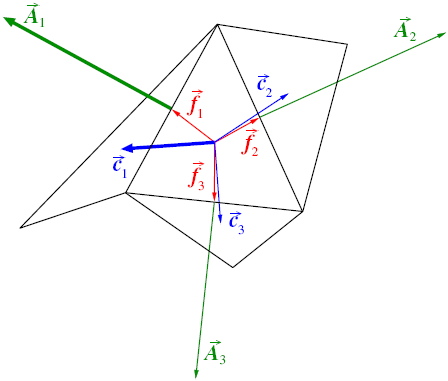Orthogonal Quality
The range for orthogonal quality is 0-1, where a value of 0 is worst and a value of 1 is best.
The orthogonal quality for cells is computed using the face normal vector, for each face; the vector from the cell centroid to the centroid of each
of the adjacent cells,
; and the vector from the cell centroid to each of the faces,
. The figure below illustrates the vectors used to determine the
orthogonal quality for a cell.

For each face, the cosines of the angle between and
, and between
and
, are calculated. The smallest calculated cosine value is the
orthogonality of the cell. Finally, Orthogonal Quality depends on
cell type:
- For tetrahedral, prism, and pyramid cells, the Orthogonal Quality is the minimum of the orthogonality and (1 - cell skewness).
- For hexahedral and polyhedral cells, the Orthogonal Quality is the same as the orthogonality.
- When the cell is located on the boundary, the vector
across the boundary face is ignored during the quality computation.
- When the cell is separated from the adjacent cell by an internal wall (for example,
a baffle), the vector
across the internal boundary face is ignored during the quality computation.
- When the adjacent cells share a parent-child relationship, the vector
is the vector from the cell centroid to the centroid of the child face while the vector
is the vector from the cell centroid to the centroid of the adjacent child cell sharing the child face.
In a similar way, orthogonal quality for faces is computed as the smallest cosine of the
angle between the edge normal vector, , for each edge and the vector from the face centroid to the centroid of
each edge,
. The figure below illustrates the vectors used to determine the
orthogonal quality for a face.



